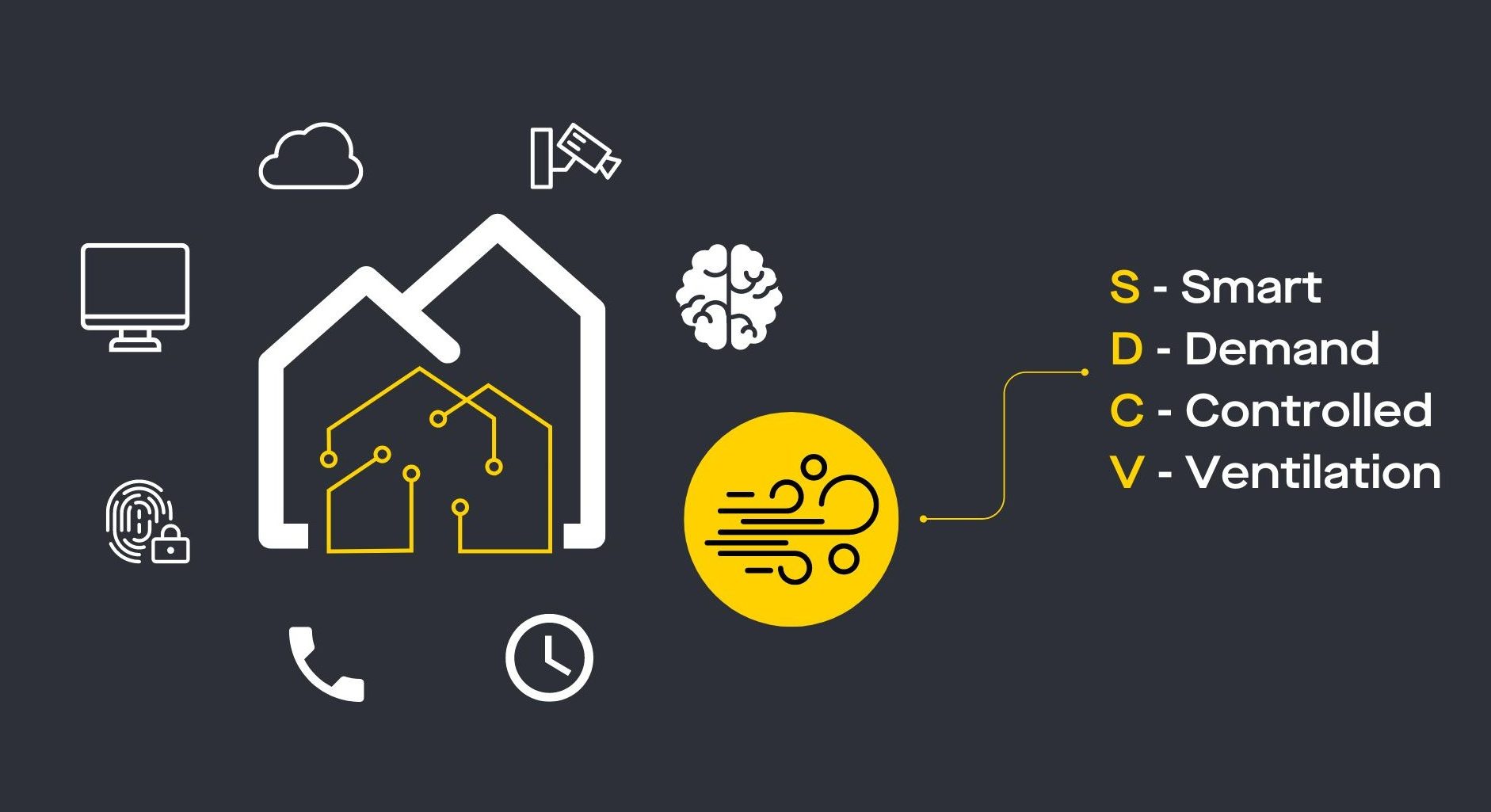Smart Demand Controlled Ventilation (SDCV)

Indoor Air Quality
Whilst there is good knowledge about outdoor air quality and pollution, the reality is that we spend 90% of our time indoors, and a lot of that at work. Indoor Air Quality (IAQ) can be 2 to 5 times worse than outside air quality, as outdoor ventilation from wind prevents pollutants from remaining concentrated in a small space.
Indoor airborne pollutants include Gases, including Volatile Organic Compounds and Nitrogen Dioxide as well as Particulate Matter (PM), which includes pollen, mold, dust, pet dander, smoke and pathogens (viruses and bacteria). Particulate Matter is measured in terms of micrograms per cubic metre (µg/m3).

The WHO has recently updated its guidelines on the permissible concentration of PM, stating that annual average concentrations of PM2.5 should not exceed 5 µg/m3, while average exposures should not exceed 15 µg/m3 for a 24 hour mean. For PM10, these should not exceed 15 µg/m3 annual mean or 25 µg/m3 for a 24 hour mean. These levels are far stricter than European, UK, and US standards, but upcoming regulatory changes are likely to adopt WHO standards.
The complexity of ventilation and building control systems is growing. It’s vital to have a solution that offers reliable control parameters to operate to their maximum potential. Smart demand ventilation uses high precision sensors and and IAQ management platform called Rensair Cloud to cater to all air purification needs efficiently.
Solutions to “clean” indoor air
There are two ways to remove indoor pollutants:
Mechanical Ventilation brings outside air into a room, extracting existing indoor air to the outside. This not only removes gases and PM, but also introduces oxygen that ensures that there is no build up of CO2 that can make occupants less attentive when it accumulates in high concentrations. It is estimated that mechanical ventilation consumes ~40% of a building’s energy. Note that buildings themselves consume ~40% of world energy, so ventilation is responsible for huge global carbon emissions. It is worth bearing in mind that mechanical ventilation can actually worsen indoor air quality if dirty outside air is brought indoors, especially for buildings near major roads or industrial plants.
Air Purification continuously filters indoor air. High Efficiency Particulate Air (HEPA) filters effectively remove airborne PM, whilst active Carbon filters can remove dangerous gases. Utilising a fraction of the energy of mechanical ventilation, air purification units are cost effective and a proven technology, having been used in the healthcare sector for over 2 decades. The drawback of air purifiers is that they cannot reduce the build-up of CO2, as they do not introduce oxygen from outside air.
Health and building authorities recommend achieving a rate of 10 litres per second per person of ventilation and/or air purification.
Smart Demand Controlled Ventilation (SDCV)
All companies and institutions have a mandate to provide a good indoor air quality and reduce carbon footprints. But higher ventilation rates require more energy consumption, which counters the net zero targets. Furthermore, office occupancy levels have reduced post pandemic – indeed occupancy rates can be very volatile from day to day.
Rensair has developed a solution for the energy and occupation issues called Smart Demand Controlled Ventilation (SDCV). By monitoring the indoor air quality and CO2 levels and connecting to a Building Management System (BMS), Rensair can optimise the mix of mechanical demand ventilation and air purification that ensures a high IAQ whilst minimising energy consumption. This will ensure that ventilation rate matches the office occupancy and reduces wasteful mechanical ventilation when cheaper air purification can do the air cleaning job. This will bring significant reductions to energy consumption, reducing a building’s carbon footprint.
Want to know more?
Stay updated with our intelligent automation built on modern sensor technologies to help create healthier and cleaner interior environments. Ensure an energy-efficient building with our specialised smart demand control ventilation, which is a cost-effective solution for landlords, tenants and commercial real estate users.
If you would like to collaborate with us, email us at contact@rensair.com or click on the button below to book a free indoor air quality consultation-
Frequently Asked Questions
What Is SDCV?
Rensair’s globally patented indoor air quality ecosystem Smart Demand Controlled Ventilation (SDCV) is transforming building management by delivering >40% reduction in HVAC energy costs and carbon emissions, while ensuring compliance with building air quality standards and enhancing occupant health, well-being, and productivity.
What is the need For Smart Demand Controlled Ventilation (SDCV)?
We spend 90 percent of our time indoors and it is estimated that indoor air quality is (2 to 5) times worse than outer air quality. For a safe & protected indoor environment, SDCV is a smart ventilation solution that effectively cleans impure air & serves cleaner and healthier indoor spaces to meet new zero goals.
What Are the Benefits of implementing SDCV in Commercial Buildings?
Smart Demand Controlled Ventilation (SDCV) offers numerous benefits for commercial buildings that include:
Improved indoor air quality: Maintaining optimal ventilation reduces the accumulation of indoor contaminants.
Energy savings: SDCV delivers >40% reduction in ventilation energy costs and carbon emissions, whilst maintaining excellent Indoor Air Quality.
Compliance with building standards: It assists in meeting building standards or green building certifications that is instrumental in meeting an organisation’s Net Zero and sustainability goals.
Enhanced Comfort: SDCV enhances occupant health, well-being, and boosts productivity.
How Does Smart Demand Control Ventilation Improve Energy Efficiency?
SDCV optimises the ventilation mix in a building by part substituting mechanical ventilation with a more cost-effective air purification and uses 9 times less energy consumed per cubic metre of air through a traditional HVAC system. The total air volume remains unchanged, but energy consumption and carbon emissions are substantially lowered by at least 40%.
What Maintenance is Required for Smart Demand Controlled Ventilation Systems?
The maintenance task includes monthly cleaning of the pre-filters, change of the HEPA filter and UVC lamp when the system indicates their end of life and timely software updates of the Rensair Cloud IoT platform.
